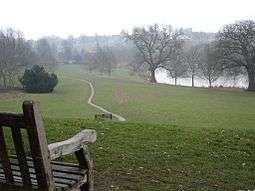Kenilworth
Kenilworth (/ˈkɛnɪlwərθ/ KEN-il-wərth) is a market town and civil parish in Warwickshire, England, about 6 miles (10 km) south-west of central Coventry, 5 miles (8 km) north of Warwick and 90 miles (140 km) north-west of London. It lies on Finham Brook, a tributary of the River Sowe, which joins the River Avon about 2 miles (3 km) north-east of the town centre. The 2011 Census recorded a parish population of 22,413.[1] The town is noted architecturally for the extensive ruins of Kenilworth Castle, the ruins of Kenilworth Abbey in Abbey Fields park, St Nicholas's Parish Church, and the town's clock tower.
| Kenilworth | |
|---|---|
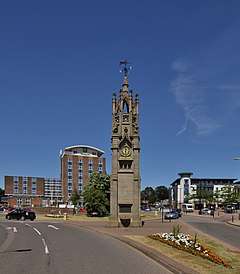 Clock tower at the junction of The Square, Smalley Place and Abbey End | |
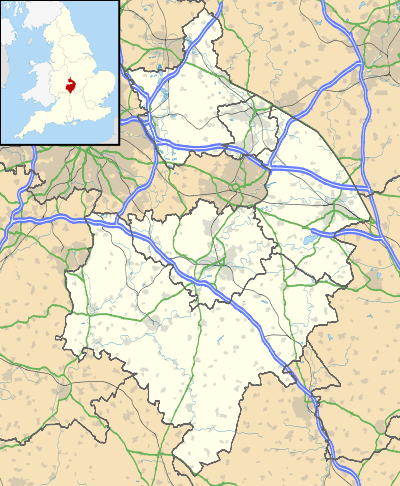 Kenilworth Location within Warwickshire | |
| Population | 22,413 (2011 Census)[1] |
| OS grid reference | SP2971 |
| Civil parish |
|
| District |
|
| Shire county | |
| Region | |
| Country | England |
| Sovereign state | United Kingdom |
| Post town | Kenilworth |
| Postcode district | CV8 |
| Dialling code | 01926 |
| Police | Warwickshire |
| Fire | Warwickshire |
| Ambulance | West Midlands |
| UK Parliament | |
| Website | https://www.kenilworthweb.co.uk/ |
History
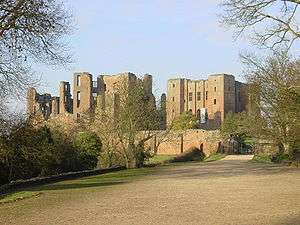
A settlement existed at Kenilworth by the time of the 1086 Domesday Book, which records it as Chinewrde, meaning "farm of a woman named Cynehild".
Geoffrey de Clinton (died 1134) initiated the building of an Augustinian priory in 1122,[2] which coincided with his initiation of Kenilworth Castle.[3] The priory was raised to the rank of an abbey in 1450[2] and suppressed with the Dissolution of the Monasteries in the 1530s. Thereafter, the abbey grounds next to the castle were made common land in exchange for what Robert Dudley, 1st Earl of Leicester used to enlarge the castle. Only a few walls and a storage barn of the original abbey survive.
Just off Coventry Road in Kenilworth is a field called Parliament Piece. This may be where Henry III held a Parliament in August 1266, while his troops besieged Kenilworth Castle, where the late Simon de Montfort's followers, led by Henry de Hastings, were still holding out against the king's forces. This Parliament led to the Dictum of Kenilworth: a settlement that offered the rebels a way of recovering the lands that the Crown had seized from them. One copy of the Dictum is endorsed in castris apud Kenilworth — "in the camp (or castle) at Kenilworth". Members of the public have free access to Parliament Piece, which is owned by the Open Spaces Society and leased to Warwick District Council.
Geoffrey de Clinton had a deer park created near Kenilworth.[2] In 1488 Ralph, abbot of Kenilworth Abbey had 40 acres (16 ha) of land near Redfern, north-west of the town, emparked as Duck Park,[2] which despite its name was a deer park. By about 1540 there were eight deer parks near Kenilworth.[2] Another near Rudfen was a 30-acre (12 ha) park that was called Little Park in 1581. It was owned by Robert Briscoe in 1649 and was still called Briscoe's Park in 1785.[2] One of the eight deer parks, The Chase, can still be traced. The eastern part of its park pale is about 1 mile (1.6 km) west of the castle, while the northern part forms the boundary between Chase Wood and the farm road and bridleway between Little Chase Farm and Warrior's Lodge Farm.
In about 1414 Henry V had le plesans en marais[4] — "The Pleasaunce in the Marsh"[2] — built about 0.5 miles (800 m) west of the castle.[5] This was a timber-framed banqueting house surrounded by a moated earthwork about 600 feet (180 m) by 500 feet (150 m), which 15th-century kings used instead of the Castle's state apartments.[5] In the 16th century, Henry VIII had the banqueting house demolished[5] and the materials reused for timber-framed buildings inside the castle.[2] The mere was drained in 1649, but "The Pleasaunce" earthworks survive as a Scheduled Monument.[4]
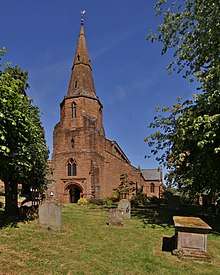
Elizabeth I visited Robert Dudley, 1st Earl of Leicester at Kenilworth Castle several times, the last in 1575. Dudley entertained the Queen with pageants and banquets costing some £1,000 per day that surpassed anything seen in England before.[6][7] These included fireworks.[8]
Warwick District Council owns and manages land across the Coventry Road at Tainter's Hill. This public open space was designated "for the poor of the parish" under an inclosure act in 1756 and is registered as common land. In 1778 Kenilworth windmill was built. Later turned into the town's water tower, it is now a private home, shorn of its sails.
In 1844 the London and Birmingham Railway opened the Coventry to Leamington Line, including Kenilworth railway station. The L&NWR had a new station built in 1883 and a new link line between Kenilworth and Berkswell in 1884 to bypass Coventry. This closed to all traffic on 3 March 1969.[9] British Rail withdrew passenger services from the Coventry to Leamington Line and closed Kenilworth Station in January 1965 in line with The Reshaping of British Railways report. In May 1977, British Rail reinstated passenger services, but did not reopen Kenilworth station, which became derelict and was eventually demolished. In 2011 Warwick Council granted John Laing plc planning permission to build a new station,[10] which was to open in 2013.[11][12] However, this was postponed by four years to December 2017.[13] In 2018, a track from Coventry was opened. There is also a track from Leamington. The train has a single carriage.
The railway in the 19th century brought industrialists from Birmingham and Coventry, to develop the residential area around the town's railway station. In the 19th century the town had some fine large mansions with landscaped gardens; these were demolished after the First World War and Second World War for housing developments. The names of them survive in the names of some roads and areas. For example, Towers Close was built on the grounds of Rouncil Towers. Some large trees from their grounds survive, including giant sequoias from the Moorlands and Rouncil Towers.
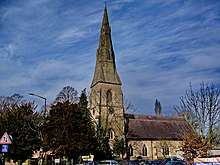
The town's growth occasioned the addition of a second Church of England parish church, St John's, which is on Warwick Road in Knights Meadow. It was designed by Ewan Christian and built in 1851–1852 as a Gothic Revival building with a south-west bell tower and broach spire.[14]
After 1883, the 1844 station in Warwick Road was partly rebuilt at the far end of Station Road behind the King's Arms and Castle Hotel. Both station and hotel were demolished in 1983, but some railway stonework remains. The old King's Arms exterior was copied and reopened in 2007 as a chain restaurant. It has distinctive pillars on its Warwick Road frontage. Sir Walter Scott stayed in the hotel when working on his novel Kenilworth.[15]
In 1884 the Parish Church of St Nicholas set up a mission room above the Co-Op in Park Road.[16] It attracted a congregation of 150 and in 1885 moved to new premises.[16] In 1905 it moved again to a "tin tabernacle" iron building newly erected in Albion Street and consecrated as Saint Barnabas Mission Church,[16] a daughter church of St Nicholas.
The railway boosted Kenilworth's market gardening. There were reputedly 40 nurseries growing market-garden produce in Kenilworth, but all have now been redeveloped for housing. The last was Guest's Nursery, which was developed as 23 houses in 2002. The Victorian era saw much expansion of the town to the west of Abbey Fields and on land around Warwick Road. Most buildings along Warwick Road date from this period and later, but a few earlier cottages survive.
The former mansion in Forrest Road, built around 1901, still stands. It is believed that a William Forrest bought the surrounding land, except that of the terrace to the north of Abbey End, and built the house either for himself or for his family. The house was split into three separate residential lots in the 1970s, the main part forming Hillcrest, the west wing with the main grand staircase and gardens Max Gate, and the billiard room the bungalow South Brent. The old landscaped gardens to the east and west of the property have been built over for housing, but the south and north gardens still belong to the house. Some features have been lost during the transition internally, but externally the house still has its grand bay windows, tiled walls, high chimney stacks and other features, which can be seen in the new flats, Mulberry Court on Abbey End. Warwick Road is now the main commercial centre of the town.
Most older buildings in Kenilworth are found in Castle Green, New Row and High Street, which has long-established shops. The age of the buildings makes it appear that this is the original settlement, but in fact it is simply the oldest part still in existence. The original settlement along present-day Warwick Road has been redeveloped continually since the 12th century and retains few original buildings. Many houses around Castle Green are built of stone salvaged in the 17th century, when the castle walls were slighted after the English Civil War.
In May 1961, the Kenilworth Society was formed over concerns about a group of 17th-century listed cottages adjacent to Finham Brook in Bridge Street.[17] It sets out to promote awareness of Kenilworth's character and encourage its preservation.
In the early 1980s, the town's name was used by one of the first generation of computer retailers, a company called Kenilworth Computers based near the Clock Tower, for its repackaging of the Nascom microcomputer with the selling point that it was robust enough to be used by agriculture.[18]
Kenilworth was struck by an F0/T1 tornado on 23 November 1981, as part of the record-breaking nationwide outbreak on that day.[19]
Modern Kenilworth
Modern Kenilworth is a dormitory town for commuters to Coventry and also Birmingham and Leamington Spa. Despite its proximity to the University of Warwick at Gibbet Hill in Coventry, it has only a small university population of mostly postgraduates and staff.
In 2008, Waitrose opened a supermarket in Kenilworth,[20] and hardware chain Robert Dyas opened a new-format store in November 2011. There are plans to renovate the existing public library. The town's old youth centre was demolished in 2007 to make way for a supermarket, and a new one was built. The Cross, a pub-restaurant, received a Michelin star in 2014.[21]
In the centre of Kenilworth stands a Kugel ball water feature, called the Millennium Globe.[22]
Since 2010, Kenilworth has belonged to Kenilworth and Southam constituency.
Districts within the town include Abbey End, Castle End, Castle Green, Crackley, Knight's Meadow, Ladyes Hill, St Johns, Whitemoor and Windy Arbour.
Transport
The A46 bypass opened in June 1974.[23] Both Birmingham Airport and the M6, M42 and M40 motorways are within 10 miles (16 km) of the town.
.jpg)
There is a regular bus service to Coventry and Leamington Spa railway stations; Warwick Parkway is 11–14 minutes' drive away. In June 2013 the government announced it would grant £5 million for the reopening of Kenilworth station, about half the proposed total cost.[24] The station, opened on 30 April 2018, has direct links to Coventry and Leamington Spa.[25] In 2019, West Midlands Trains services from Leamington Spa to Nuneaton commenced calling at the station.[26]
Sports
Kenilworth Town FC, in Gypsy Lane south of the town, played in the Midland Combination until June 2011, when it resigned,[27] preferring to spend money on ground improvements rather than fielding a team. It re-entered the English football pyramid in the 2013–14 season and was placed in the Midland Football League Division 3, the 12th highest tier in the English league system. The stay, however, was brief: the first team again resigned shortly afterwards. The Gypsy Lane ground was purchased in 2018 by Coventry Plumbing F.C., which demolished the clubhouse and built a new one, before starting the 2019–20 season there.[28][29]
Kenilworth Wardens FC is based at Kenilworth Wardens, a Community Amateur Sports Club in Glasshouse Lane to the east of the town.[30]
Kenilworth RFC is the town's rugby union club. It fields three senior sides and hosts a large minis, juniors and colts section. The ground is also located in Glasshouse Lane.[31]
Kenilworth Tennis, Squash and Croquet Club, in Crackley Lane, has nine tennis courts, five squash and racketball courts and two croquet lawns.[32]
Kenilworth has two cricket clubs. Kenilworth Wardens in Glasshouse Lane fields five senior teams and a juniors section starting from seven years old.[33] Kenilworth Cricket Club fields three senior teams and plays at the Warwick Road ground.[34]
Kenilworth Runners meets at the Wardens. It caters for runners of all ages and abilities.[35]
Octavian Droobers is the local orienteering club, using maps of Abbey Fields and Kenilworth Common on which to stage events.
Kenilworth Wheelers meets all the year round on Saturday and Sunday morning for a road ride. During the summer months, regular evening training rides cater for all abilities from novice to racer.[36]
Abbey Fields Swimming Pool is in Abbey Fields. It has a 25 m by 10 m indoor pool and an outdoor pool open from May to September. It is home to Kenilworth Swimming Club and Kenilworth Masters Swimming Club.[37]
Kenilworth Golf Club features a mature 18-hole parkland course, plus a small six-hole par 3 course.[38]
Castle Farm Recreation Centre has a four-court badminton hall suitable for basketball, volleyball, netball, table tennis, short mat bowls and children's parties. It is available for use by the public and by sports clubs that make block bookings throughout the year.
Two Castles Run
The Two Castles Run began in 1983 as a fun run between Warwick Castle and Kenilworth Castle.[39] It has grown into an English Athletics-licensed run with 3,000 entrants in 2010.[40] In 2010 and 2011 it held the Warwickshire Amateur Athletic Association 10 Kilometre Championship. In 2012 all 4,000 places were sold within 25 hours. The race is organised each June by Kenilworth Rotary Club[41] in conjunction with the Leamington Cycling and Athletic Club.[42][43]
Arts
Theatres
The Talisman Theatre, founded as Talisman Players in 1942, moved to its current 156-seat premises in Barrow Road in 1969.[44] It won eight NODA awards between 2004 and 2014.[45]
The Priory Theatre, founded in 1932 as the Kenilworth Players, uses the former Unitarian/Christadelphian chapel, a Gothic Revival building[2] dating from 1816, which was converted into a 119-seat theatre building in 1945–1946.[46] It was gutted by fire in 1976, but restored and reopened in September 1978.[46]
Kenilworth Arts Festival
The first Kenilworth Festival was held in 1935. After a 70-year interval, it was revived locally in 2005. Between 2005 and 2015, events were held almost every year, with varying success.[47] The company became a social enterprise in 2010.[48] In 2015/16, a new team oversaw a change in direction, with a new name, branding and mission statement, as Kenilworth Arts Festival, its focus being to "celebrate and support high quality, original work within the contemporary arts."
The inaugural Kenilworth Arts Festival, in September 2016, featured singer-songwriters Rachel Sermanni and Luke Jackson, jazz pianist Jason Rebello, BAFTA fellow Andrew Davies, classical duo the Ayoub Sisters, nature-writer Rob Cowen, and poets David Morley, Sarah Howe, Jo Bell and Luke Kennard. The second edition of the festival took place in September 2017, with well-known participants including singer-songwriter John Smith, pianist Gwilym Simcock, nature writer Alys Fowler and novelists Kit de Waal and Sarah Moss.
In 2018, Kenilworth Arts Festival expanded to 10 days, running from 20–29 September. The festival featured over 30 events, with headliners including American musicians S. Carey and Jesca Hoop; pianist Zoe Rahman; nature writer John Lewis-Stempel and novelists Kamila Shamsie, Donal Ryan, Kit de Waal, Fiona Mozley and Kiran Millwood Hargrave. The festival secured funding from Arts Council England.
Kenilworth Arts Festival took place again on 19–28 September 2019.[49]
Notable people
In order of birth:
- Henry III of England (1207–1272) commissioned the Dictum of Kenilworth, which was made public on 31 October 1266.[50]
- Edward II of England (1284–1327) was held prisoner in Kenilworth Castle in 1326–1327.[51]
- Robert Dudley, 1st Earl of Leicester (1532 or 1533–1588) lived at Kenilworth Castle.[52]
- Thomas Underhill (1545–1591) was keeper of the wardrobe at Kenilworth Castle.
- Thomas Hearne (1744–1817), landscape artist, painted The Priory Gate at Kenilworth in 1784.[53]
- William Field (1768–1851), Unitarian minister and local historian, served the Old Meeting House at Kenilworth from about 1830 to 1850.[54]
- Sir Walter Scott's (1771–1832) novel Kenilworth. A Romance appeared anonymously in 1821.[55]
- Samuel Butler (1774–1839), classical scholar and bishop, became the incumbent of Kenilworth in 1802.[56]
- John Sumner (1780–1862), Archbishop of Canterbury, was born in Kenilworth.[57]
- Charles Sumner (1790–1874), religious writer and bishop, was born in Kenilworth.[58]
- William Gresley (1801–1876), religious writer and cleric, was born in Kenilworth.[59]
- Samuel Carter MP (1805–1878), inherited property in Kenilworth and is buried in the graveyard of St Nicholas.[60][61]
- Anna Russell (1807–1876), botanist, lived in Kenilworth.[62]
- Samuel Hawksley Burbury (1831–1911), mathematician, was born in Kenilworth.[63]
- Isabel, Lady Burton (née Arundell, 1831–1896), religious writer and wife of the scholar Richard Francis Burton, was born in Kenilworth.[64]
- George Potter (1832–1893), trade unionist, first president of the Trades Union Congress of England and Wales, was born in Kenilworth.
- Sir Arthur Sullivan's (1842–1900) long association with vocal music began with a cantata, The Masque at Kenilworth, in 1864.[65]
- Jack Burns (1859–1927), Scottish champion golfer, was instrumental in creating the Kenilworth course in 1890.[66]
- Oliver Bodington (1859–1936), Paris-based international lawyer and marriage broker, was baptised in Kenilworth.[67]
- Edith Emma Cooper (1862–1913) was one half of Michael Field, known as a poet, dramatist and diarist.
- Edgar Jepson (1863–1938), writer of crime, adventure and fantasy novels, was born in Kenilworth.[68]
- John Siddeley, Lord Kenilworth (1866–1953), motor and aero engineering pioneer, moved to Crackley Hall, Kenilworth, in 1918.
- Reginald Lee (1870–1913), surviving crew member of the RMS Titanic, died in Kenilworth.[69]
- Walter Ritchie (1919–1991), sculptor, lived and worked in Kenilworth.[70]
- Basil Heatley (born 1933 in Kenilworth) was a marathon runner and Olympic silver medallist.[71]
- Andrew Davies (born 1936), is novelist and screenwriter who lives in Kenilworth (the 1995 BBC Pride and Prejudice).[72]
- Julia Slingo (born 1950), climate scientist and Dame Commander of the Order of the British Empire, was born in Kenilworth.[73]
- Peter Marlow (1952–2016) was a photojournalist and photographer.
- Tim Flowers (born 1967 in Kenilworth) is an Association football goalkeeper, notably for Southampton and Blackburn Rovers. He was capped 11 times by England.[74]
- Rebecca Probert (born 1973), legal historian and expert on marriage law, lives in Kenilworth with her travel-writer husband Liam D'Arcy Brown.[75]
- Kelvin Langmead (born 1985), professional football player for Kidderminster Harriers, was educated at Kenilworth School.[76]
- Sarah-Jane Perry (born 1990), professional international squash player, was educated at Kenilworth School.[77]
Twin towns
Kenilworth is twinned with:


Kenilworth also has friendship links with:
- Roccalumera, Italy

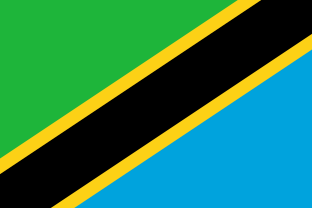
References
- "Area: Kenilworth (Parish): Key Figures for 2011 Census: Key Statistics". Neighbourhood Statistics. Office for National Statistics. Retrieved 13 December 2013.
- Salzman 1951, pp. 132–143.
- English Heritage. Retrieved 10 November 2018.
- Historic England. "The Pleasance moated site (1007720)". National Heritage List for England. Retrieved 10 December 2011.
- Pevsner & Wedgwood 1966, p. 325.
- Information about Elizabethan masques Archived 21 October 2007 at the Wayback Machine
- Shepherd, Marc (24 December 2003). "Kenilworth (1864)". Gilbert & Sullivan Discography. Archived from the original on 25 June 2008.
- Langham, Robert (1580). Langham letter.
- Warwickshire Railways - Kenilworth JunctionWarwickshire Railways website article; Retrieved 3 September 2013
- "Planning Application WDC/10CC067". Warwickshire County Council. Retrieved 14 September 2011.
- "John Laing picks up NUCKLE station build contract". Transport Briefing. Acumen Intelligence Ltd. Retrieved 14 September 2011.
- "Contracts signed to build new Kenilworth rail station". Coventry Telegraph. 24 July 2009. Retrieved 14 September 2011.
- "Green light for Kenilworth station". Press release. Department for Transport. 12 December 2013. Retrieved 13 December 2013.
- Pevsner & Wedgwood 1966, p. 319.
- "Sir Walter Scott's memory will live on as plaque is found". Kenilworth Weekly News. 22 October 2010. Retrieved 13 December 2011.
- "History of St Barnabas Church". St Nicholas & St Barnabas Churches Kenilworth. Benefice of St NIcholas & St Barnabas, Kenilworth. Archived from the original on 26 April 2012. Retrieved 10 December 2011.
- "The Kenilworth Society". Retrieved 28 May 2012.
- http://www.nascomhomepage.com/pdf/Kenilworth_case.pdf
- European Severe Weather Dabase Retrieved 10 November 2018.
- "Warwickshire gets its first Waitrose". Coventry Telegraph. 31 July 2008. Retrieved 25 March 2018.
- Michelin Planner Retrieved 20 March 2017.
- Snoeijer, Jacco H. "Physics of the granite sphere fountain" (PDF). American Associate of Physics Teachers. Retrieved 19 November 2016.
- "Derek, 93, gets award of merit". Kenilworth Weekly News. 31 May 2007. Retrieved 25 March 2018.
- "Funding pledge for Kenilworth railway station". Global Rail News. Rail Media. 3 June 2013. Retrieved 3 June 2013.
- Kenilworth Station Retrieved 23 January 2018.
- "May Timetable Changes". West Midlands Railway. Retrieved 14 June 2019.
- "Kenilworth Pull Out Of Midland Comb". Pitch Hero Non-League. 6 June 2011.
- "'We're bringing football back' say soon-to-be owners of old Kenilworth Town FC land". Kenilworth Weekly News. 10 September 2018.
- "Directory". Midland Football League. Retrieved 18 February 2020.
- "Kenilworth Wardens". Retrieved 28 May 2012.
- "Kenilworth RFC". Retrieved 28 May 2012.
- "Kenilworth Tennis Club". Archived from the original on 14 January 2012. Retrieved 28 May 2012.
- "Kenilworth Wardens". Retrieved 28 May 2012.
- "Kenilworth Cricket Club". Archived from the original on 27 September 2011. Retrieved 28 May 2012.
- "Kenilworth Runners". Retrieved 28 May 2012.
- "Kenilworth Wheelers". Retrieved 28 May 2012.
- "Kenilworth Masters". Retrieved 28 May 2012.
- "Kenilworth Golf Club". Retrieved 28 May 2012.
- Rotary Club of Kenilworth Retrieved 10 November 2018.
- English Athletics.
- Kenilworth Rotary Club.
- Leamington Cycling and Athletic Club.
- Two Castles Run.
- "About us". Talisman Theatre and Arts Centre. Retrieved 10 December 2011.
- "Archive". Talisman Theatre and Arts Centre. Retrieved 15 October 2014.
- "History". About Us. Priory Theatre. Retrieved 10 December 2011.
- "Kenilworth Festival makes comeback". Kenilworth Weekly News. 11 February 2008.
- Telegraph, Coventry (16 May 2011). "Kenilworth Festival 2011 comes to successful end (Pictures)". Coventry Telegraph. Retrieved 20 March 2018.
- Retrieved 18 February 2020.
- Rothwell, H., ed. (1975), English Historical Documents III, 1189–1327, London, p. 380.
- J. R. S. Phillips, "Edward II (1284–1327)", Oxford Dictionary of National Biography accessed 18 April 2014
- Haynes, Alan (1992): Invisible Power: The Elizabethan Secret Services 1570–1603, p. 12.
- Retrieved 18 April 2014.
- "Field, William". Dictionary of National Biography. London, 1885–1900.
- British Library catalogue. Retrieved 18 April 2014.
- Chisholm, Hugh, ed. (1911). Encyclopædia Britannica (11th ed.) Cambridge University Press.
- Edward J. Davies, "Some Connections of the Birds of Warwickshire", The Genealogist, 26 (2012): pp. 58–76.
- "Ridley, William Henry". Dictionary of National Biography. London, 1885–1900.
- Goodwin, Gordon (1890). "Gresley, William". In Stephen, Leslie; Lee, Sidney. Dictionary of National Biography 23. London: Smith, Elder & Co. pp. 153–55.
- "Samuel Carter". Dictionary of Unitarian and Universalist Biography. Retrieved 20 March 2018.
- "Carter, Samuel". Oxford Dictionary of National Biography (online ed.). Oxford University Press. doi:10.1093/ref:odnb/49346. (Subscription or UK public library membership required.)
- Creese, Mary R. S. (2000). Ladies in the Laboratory? American and British Women in Science, 1800–1900: A Survey of Their Contributions to Research. Scarecrow Press. pp. 31–32. ISBN 9780585276847.
- "Burbury, Samuel Hawksley". Dictionary of National Biography, 1912 suppl. London.
- Lovell, Mary S., A Rage to Live, W. W. Norton, 1998.
- Robin Gordon-Powell (Archivist & music librarian of the Sir Arthur Sullivan Society), Preface to score of Kenilworth, London, 2002.
- "Club History". Kenilworth Golf Club. Retrieved 27 September 2013..
- Joseph Foster: Men-at-the-Bar (1885), p. 42.
- "Edgar Jepson, 74, English Novelist". The New York Times (Wireless to The New York Times), 12 April 1938, p. 23.
- Mr Reginald Robinson Lee – Titanic Biography – Encyclopedia Titanica at www.encyclopedia-titanica.org
- Rogers, Byron, The Arts: Sculpture - do's and don'ts Walter Ritchie's career...The Sunday Telegraph 12 May 1996.
- Sporting Heroes.
- Retrieved 16 November 2019.
- "Slingo, Prof. Julia Mary". Who's Who 2014, A & C Black, 2014.
- Soccer Base stats Retrieved 28 November 2014.
- Professor Probert's Warwick University webpage
- Squashinfo
- Squashinfo. Retrieved 18 April 2014.
Sources
- Pevsner, Nikolaus; Wedgwood, Alexandra (1966). Warwickshire. The Buildings of England. Harmondsworth: Penguin Books. pp. 317–326.CS1 maint: ref=harv (link)
- Salzman, LF, ed. (1951). "Kenilworth". A History of the County of Warwick. Victoria County History. 6: Knightlow hundred. London: Oxford University Press for the Institute of Historical Research. pp. 132–143.CS1 maint: ref=harv (link)
External links
| Wikimedia Commons has media related to Kenilworth. |
- Kenilworth The Best Kept Secret in Warwickshire — official Kenilworth town centre website
- Kenilworth Chamber of Trade
- Geograph photos of Kenilworth and surrounding area
- Kenilworth local history articles and books
- Kenilworth in the Second World War
- Catalogue of the Kenilworth Urban District Council archives held at the Modern Records Centre, University of Warwick
- Warwickshire Geological Conservation Group (WGCG) is based in Kenilworth
